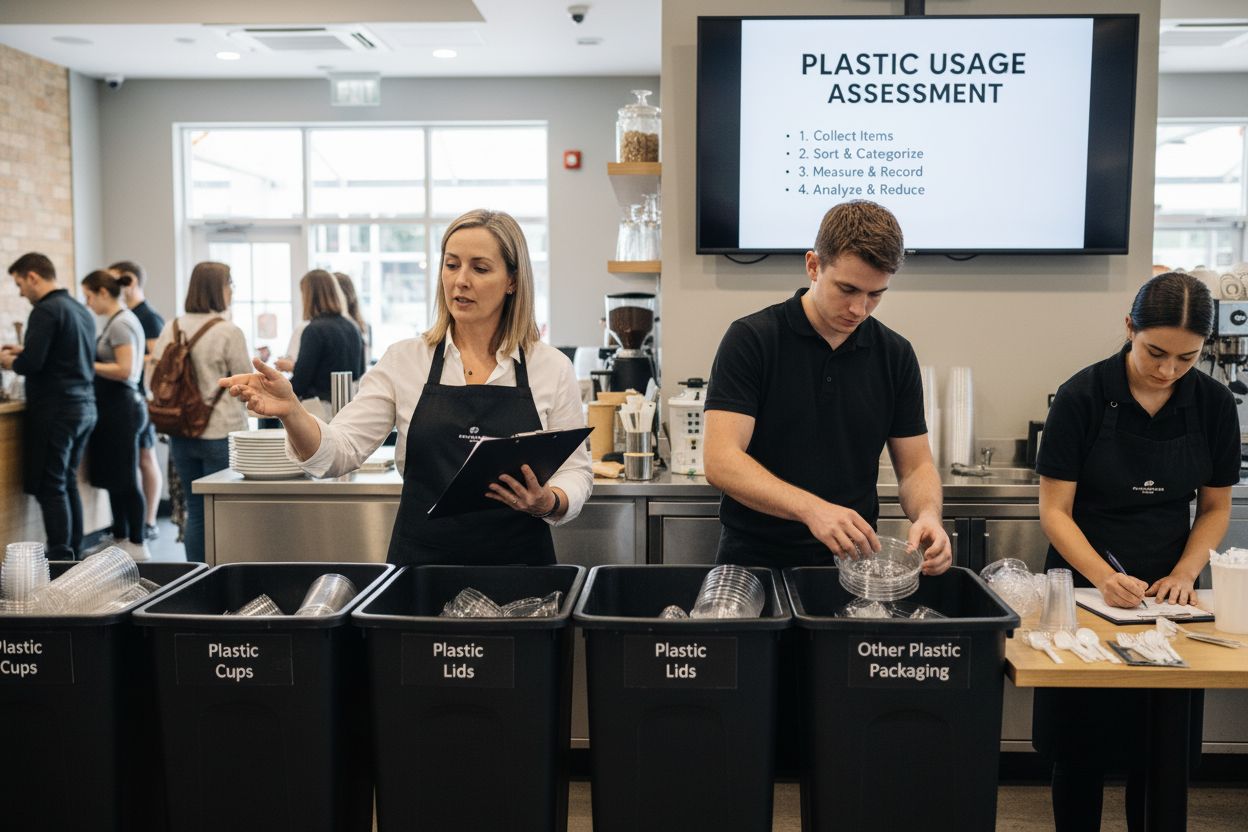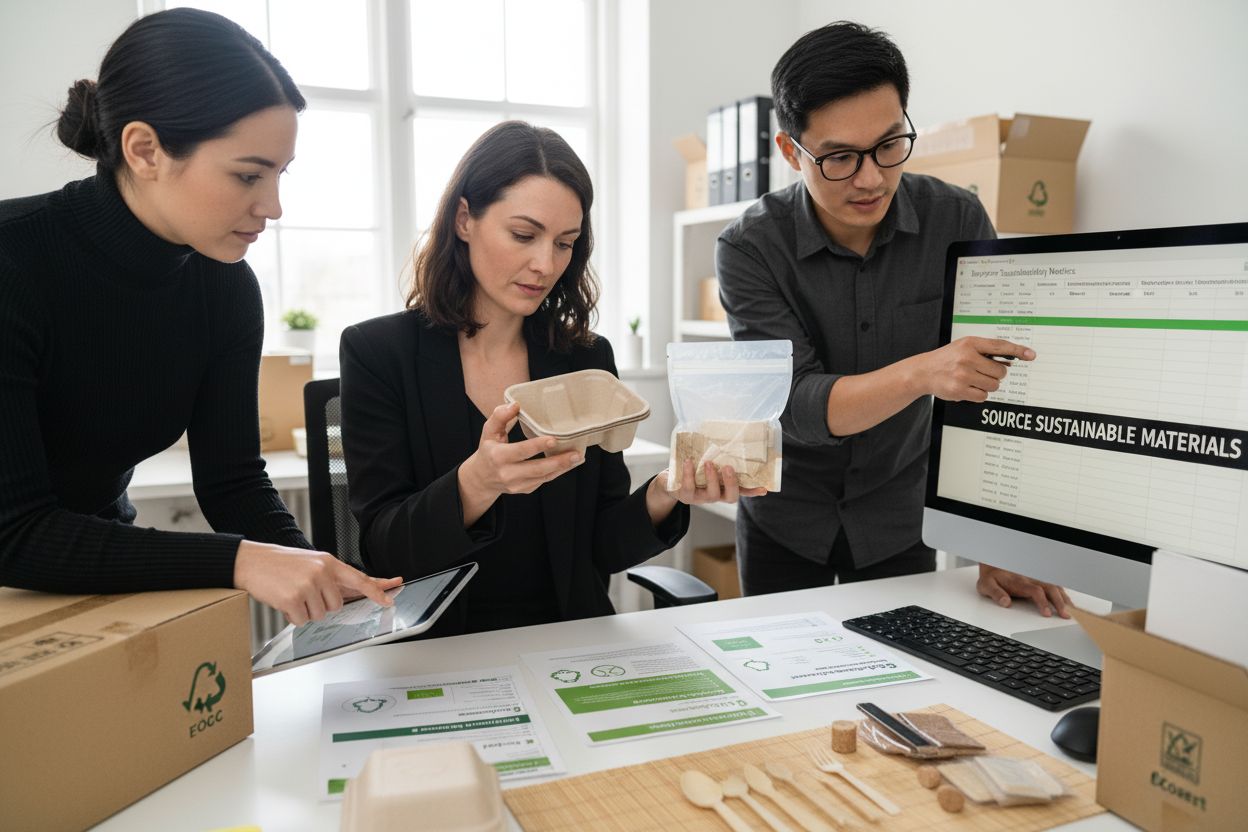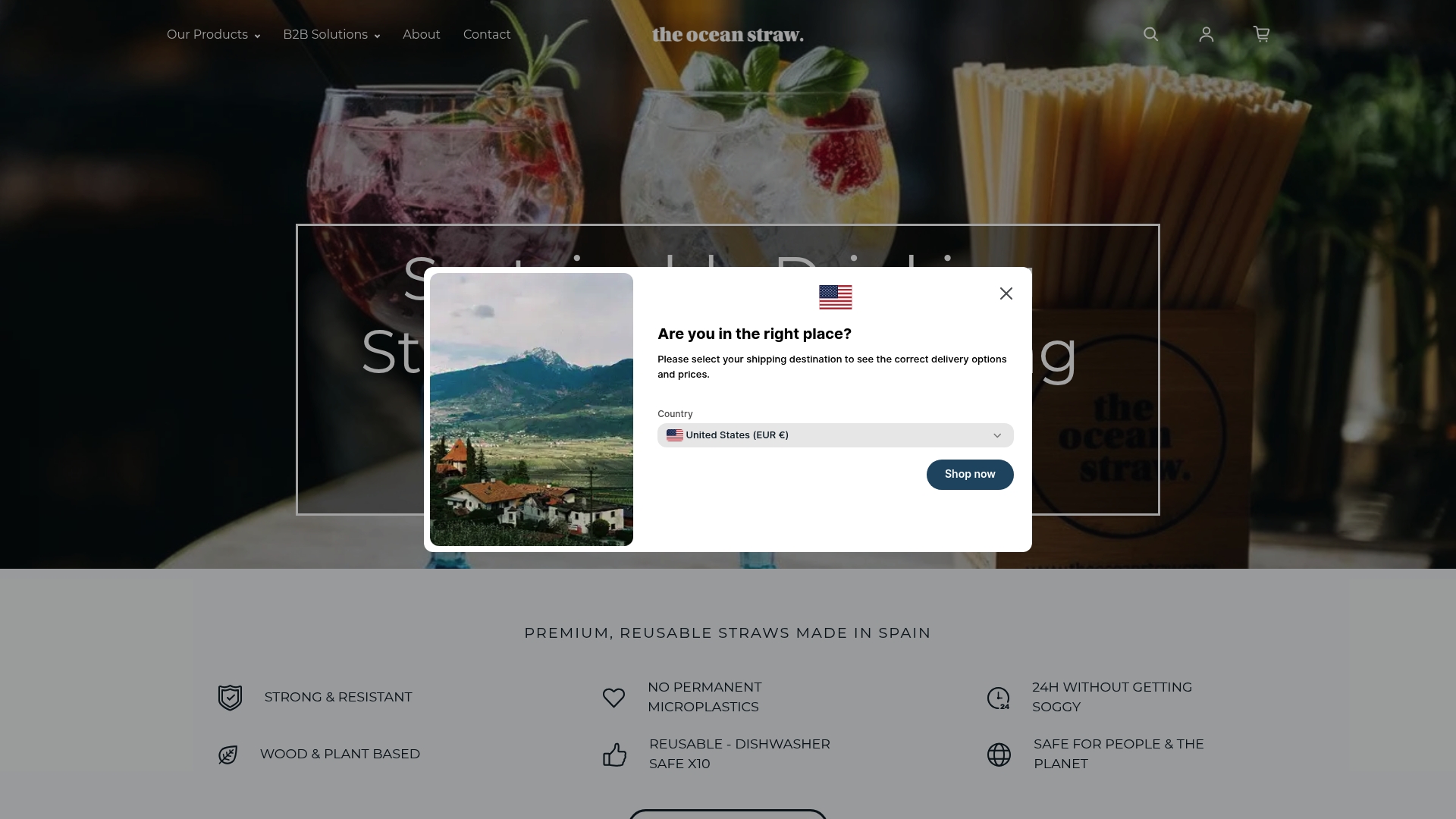How to Prevent Plastic Pollution in the Ocean: A Practical Guide

Businesses everywhere rely on plastic for everything from packaging to utensils, yet every year over 8 million tons of plastic end up in our oceans. Most people expect the problem starts far from their doors with massive factories or offshore dumping. Surprisingly, even a single restaurant or hotel can cut its plastic waste by up to 60% in just one year through the right strategies. The biggest impact on ocean plastic starts with a few simple steps inside your own establishment.
Table of Contents
- Step 1: Assess Current Plastic Usage In Your Establishment
- Step 2: Implement Initial Waste Reduction Strategies
- Step 3: Source Sustainable And Eco-Friendly Materials
- Step 4: Educate Staff And Guests On Plastic Waste Reduction
- Step 5: Monitor And Review Your Progress Regularly
Quick Summary
| Key Point | Explanation |
|---|---|
| 1. Conduct a thorough plastic inventory | Assess all plastic materials used to identify waste sources and create a baseline for reduction efforts. |
| 2. Focus on eliminating unnecessary plastics | Target items that can be quickly replaced or removed without disrupting operations, such as single-use plastics. |
| 3. Source sustainable materials | Choose eco-friendly alternatives that minimize environmental impact and prioritize vendors committed to sustainability. |
| 4. Educate staff and guests | Implement comprehensive training and communication strategies to build awareness and engagement in plastic waste reduction. |
| 5. Regularly monitor and review progress | Establish tracking systems to measure results, adapt strategies, and celebrate successes in reducing plastic waste. |
Step 1: Assess Current Plastic Usage in Your Establishment
Reducing plastic pollution in the ocean starts with a comprehensive understanding of your current plastic consumption. This critical first step involves a detailed audit of all plastic materials used within your establishment, revealing hidden sources of potential waste and providing a strategic baseline for meaningful reduction.
Conducting a Comprehensive Plastic Inventory
Begin by scheduling a thorough walkthrough of your entire facility. Walk through each department and area where plastic materials are utilized, from the kitchen to storage areas, administrative spaces, and customer service zones. Carry a dedicated notebook or digital tracking tool to document every single plastic item encountered.
Documenting plastic usage requires meticulous attention to detail. Record specific quantities, types, and frequencies of plastic items such as packaging materials, disposable utensils, wrapping, containers, and single-use products. Pay special attention to items that might seem insignificant but collectively contribute substantial plastic waste. Examine everything from drinking straws and cutlery to packaging materials and cleaning supply containers.
As you document your findings, categorize plastic items based on their potential for replacement or elimination. Create three primary classification groups:
- Essential Use: Plastics absolutely critical for operational requirements
- Reducible Use: Plastics that could be minimized or substituted
- Unnecessary Use: Plastic items that can be immediately eliminated
Consider engaging your staff in this assessment. They often have valuable insights into daily operational practices and can help identify unexpected sources of plastic consumption. Their participation also builds awareness and commitment to reducing plastic waste.
According to National Oceanic and Atmospheric Administration, businesses that conduct comprehensive plastic inventories can reduce their plastic waste by up to 40% through targeted interventions. This statistic underscores the importance of a detailed, systematic approach to plastic assessment.
To verify the completeness of your inventory, cross-reference your documented list with purchasing records, conduct staff interviews, and review waste management logs.
Below is a checklist table to help you verify the completeness and accuracy of your establishment’s plastic usage inventory process.
| Verification Step | Purpose | How to Complete |
|---|---|---|
| Cross-reference with purchasing records | Ensure all plastic items are accounted for | Review past orders and compare with your inventory |
| Conduct staff interviews | Identify overlooked or hidden plastic usage | Ask operational staff for insights and observations |
| Review waste management logs | Spot items frequently discarded that may be missed | Analyze logs for recurring plastic waste |
| Categorize items by usage necessity | Prioritize reduction strategies | Sort each item as Essential, Reducible, or Unnecessary |
| Engage staff in the process | Improve accuracy and foster commitment | Invite team input and suggestions during assessment |
| Document types and quantities | Establish a detailed baseline for reduction | Log specific items, amounts, and usage frequency |
| Audit all departments and spaces | Ensure complete coverage of your facility | Visit kitchen, storage, admin, and service areas |
![]()
Step 2: Implement Initial Waste Reduction Strategies
After completing your comprehensive plastic usage inventory, the next critical phase involves translating your findings into actionable waste reduction strategies. This step focuses on creating meaningful changes that will significantly decrease your establishment’s plastic footprint and contribute to ocean plastic pollution prevention.
Prioritizing Strategic Plastic Elimination
Transitioning from assessment to implementation requires a systematic and thoughtful approach. Begin by targeting the unnecessary and reducible plastic items identified in your initial inventory. Start with the lowest hanging fruit - plastic products that can be immediately eliminated without disrupting core business operations.
Replace single-use plastic items with sustainable alternatives. For instance, switch from disposable plastic utensils to reusable or compostable options. Look for wood-based or plant-based solutions that provide similar functionality while minimizing environmental impact. Focus on high-volume, frequently used items such as straws, cutlery, packaging, and food containers.
This table summarizes common sustainable alternatives for replacing high-volume single-use plastic items mentioned in the article along with their key benefits.
| Plastic Item Type | Sustainable Alternative | Key Benefits |
|---|---|---|
| Straws | Compostable wood/plant-based straws | Biodegradable, reduces marine pollution |
| Utensils | Reusable or compostable utensils | Minimizes single-use waste, eco-friendly |
| Packaging | Plant-based or biodegradable packaging | Reduces landfill waste, safer for oceans |
| Containers | Biodegradable/compostable containers | Decomposes naturally, supports sustainability |
| Wrapping Materials | Paper-based or plant-based wraps | Minimizes plastic footprint, renewable |
Establish clear procurement guidelines that prioritize plastic-free or minimal plastic options. Communicate these new standards with your suppliers and purchasing team. Request alternative packaging solutions and seek vendors who demonstrate commitment to sustainable practices. This approach not only reduces your plastic consumption but also sends a powerful message to your supply chain about environmental responsibility.
Encourage staff participation by creating incentive programs and training sessions that highlight the importance of plastic reduction. Develop internal communication strategies that make waste reduction feel like a collective mission rather than an imposed requirement. Staff who understand the environmental impact are more likely to embrace and champion these changes.
According to United Nations Environment Programme, businesses that implement strategic waste reduction can decrease plastic waste by up to 60% within the first year of focused efforts. This statistic underscores the potential impact of deliberate, systematic plastic elimination strategies.
To verify the success of your initial waste reduction strategies, conduct monthly audits comparing your current plastic consumption against the baseline established in your initial inventory. Look for consistent reductions in plastic item quantities and track the financial and environmental benefits of your new approach. Celebrate incremental wins and use data to refine and improve your ongoing plastic reduction efforts.
Step 3: Source Sustainable and Eco-friendly Materials
Transitioning from plastic reduction strategies to sourcing sustainable materials represents a critical evolution in preventing ocean plastic pollution. This step involves deliberately selecting materials that minimize environmental impact while maintaining operational efficiency and product quality.
Begin by comprehensively researching suppliers committed to sustainable practices. Look beyond marketing claims and request detailed documentation about material sourcing, production processes, and environmental certifications. Prioritize vendors who demonstrate transparent supply chain practices and genuine commitment to ecological preservation.
Focus on identifying materials with minimal environmental footprint. Wood-based and plant-based alternatives offer exceptional opportunities for sustainable replacement. Consider materials that are biodegradable, renewable, and sourced through responsible forestry or agricultural practices. learn more about environmentally friendly products to understand the broader context of sustainable material selection.
When evaluating potential sustainable materials, consider several key assessment criteria. Analyze the complete lifecycle of the material, from raw resource extraction to end-of-life disposal. Examine factors such as water usage during production, carbon emissions, regenerative potential, and decomposition timelines. Prioritize materials that offer closed-loop sustainability, meaning they can be fully recycled or naturally decompose without leaving harmful residues.
Establish robust vendor evaluation protocols that go beyond traditional cost considerations. Create a scoring system that weights environmental impact alongside economic factors. This approach ensures you select materials that are not just environmentally responsible but also financially viable for your establishment.
According to World Economic Forum, businesses that proactively source sustainable materials can reduce their environmental footprint by up to 50% and often discover long-term cost savings through more efficient resource utilization.
To verify the success of your sustainable material sourcing, conduct regular audits comparing new materials against your previous plastic-based products. Track metrics such as waste reduction, carbon emission decreases, and overall environmental impact. Document these findings to demonstrate your establishment’s commitment to ocean conservation and sustainable business practices.

Step 4: Educate Staff and Guests on Plastic Waste Reduction
Education serves as a powerful catalyst for transforming organizational culture and driving meaningful environmental change. This critical step focuses on creating comprehensive awareness and engagement strategies that empower both staff and guests to actively participate in plastic waste reduction efforts.
Begin by developing a structured training program for your staff that goes beyond standard procedural instructions. Create immersive learning experiences that connect plastic pollution to real-world environmental impacts. Utilize multimedia presentations, interactive workshops, and compelling visual storytelling that illustrate the direct connection between individual actions and ocean ecosystem health.
Design training modules that are engaging and practical. Break down complex environmental concepts into clear, actionable insights that staff can immediately implement in their daily responsibilities. Incorporate specific scenarios relevant to your establishment, demonstrating how each team member can contribute to plastic waste reduction. Highlight the economic and environmental benefits of these practices to foster genuine motivation and understanding.
Extend your educational efforts to guest engagement by developing clear, compelling communication strategies. Implement visible signage explaining your plastic reduction initiatives, use table tents or menu inserts that describe your sustainable practices, and train staff to communicate these efforts naturally during guest interactions. Create an narrative that makes guests feel like active participants in your environmental mission rather than passive observers.
Develop incentive programs that encourage both staff and guests to embrace plastic reduction. Consider implementing recognition systems for staff members who demonstrate exceptional commitment to sustainable practices. For guests, explore creative approaches like small discounts or special acknowledgments for choosing plastic-free options.
According to National Oceanic and Atmospheric Administration, educational initiatives can increase environmental awareness and behavior change by up to 65%, making this step crucial in your plastic pollution prevention strategy.
To verify the effectiveness of your educational efforts, conduct periodic assessments through staff feedback surveys, guest questionnaires, and direct observations of behavior changes. Track metrics such as reduced plastic usage, increased engagement with sustainable alternatives, and overall team and guest understanding of your environmental initiatives. Continuously refine your approach based on these insights, creating a dynamic, evolving educational strategy that maintains momentum and drives meaningful environmental impact.
Step 5: Monitor and Review Your Progress Regularly
Consistent monitoring and review form the backbone of successful plastic pollution reduction efforts. This critical step transforms your initial strategies into a dynamic, adaptive approach that ensures continuous improvement and meaningful environmental impact.
Establish a comprehensive tracking system that goes beyond simple quantitative measurements. Design a multifaceted monitoring framework that captures both tangible plastic reduction metrics and qualitative aspects of your organizational transformation. Create detailed spreadsheets or utilize specialized sustainability tracking software to document your progress systematically.
Implement monthly review sessions that bring together key stakeholders from different departments. During these meetings, analyze data collected from waste audits, purchasing records, and staff feedback. Look for patterns, identify challenges, and celebrate successes. Develop a culture of transparent reporting where data is shared openly, encouraging collective accountability and continuous learning.
Utilize both digital and physical tracking tools to capture a holistic view of your plastic reduction journey. Consider creating visual dashboards that display real-time progress, making the impact of your efforts immediately visible to staff and guests. These visual representations can serve as powerful motivational tools, demonstrating the tangible results of your environmental commitment.
Design a flexible adaptation strategy that allows for quick pivots based on your monitoring insights. Not every initial approach will yield perfect results, so build flexibility into your tracking and review process. Be prepared to modify strategies, experiment with new approaches, and learn from both successful and unsuccessful interventions.
According to Environmental Protection Agency, organizations that implement rigorous monitoring systems can improve their waste reduction efficiency by up to 40% within the first year of dedicated tracking.
To verify the effectiveness of your monitoring efforts, establish clear key performance indicators (KPIs) that measure both quantitative and qualitative progress. These might include total plastic volume reduced, staff engagement levels, guest feedback scores, and financial savings from sustainable practices. Conduct quarterly comprehensive reviews that not only assess current performance but also set progressively ambitious goals for future plastic pollution prevention efforts. Remember, monitoring is not about achieving perfection but about demonstrating consistent, meaningful progress in your environmental stewardship.
Ready to Eliminate Plastic Waste with a Real Solution?
If you have identified unnecessary plastic use and want a simpler way to drive meaningful change at your restaurant or bar, it is time to act. Swapping out plastic straws is a proven, high-impact step you can take right away. The Ocean Straw Growth Pack offers wood and plant-based compostable straws designed specifically for the HoreCa market. Unlike other alternatives, these sustainable straws fit your daily operations while aligning with the responsible practices described in this guide.

Join countless businesses who have already reduced their plastic footprint. Visit theoceanstraw.com to explore how you can get started today, or discover more about our eco-friendly business solutions. Take action now and become part of the effort to protect our oceans—your guests and the planet will thank you.
Frequently Asked Questions
What is the first step in preventing plastic pollution in the ocean?
The first step involves assessing your establishment’s current plastic usage through a comprehensive audit. This helps identify sources of plastic waste and establishes a baseline for reduction efforts.
How can businesses reduce unnecessary plastic use?
Businesses can reduce unnecessary plastic use by categorizing plastic items based on their essentiality, targeting unnecessary and reducible products for immediate elimination, and replacing single-use plastics with sustainable alternatives.
What are some sustainable alternatives to common plastic items?
Sustainable alternatives include using reusable or compostable utensils instead of disposable plastic ones, choosing wood-based or plant-based solutions for packaging, and opting for biodegradable containers.
How can staff engagement boost plastic reduction efforts?
Engaging staff through training and incentive programs fosters a culture of environmental responsibility, encourages ideas for reducing plastic waste, and enhances commitment to plastic reduction initiatives.